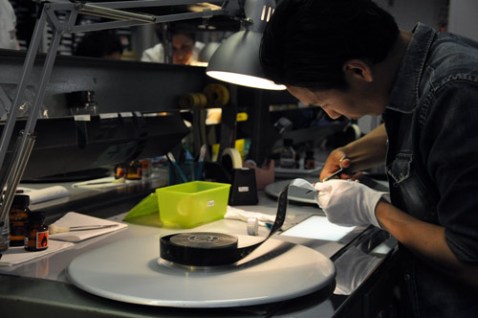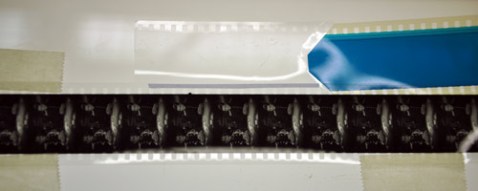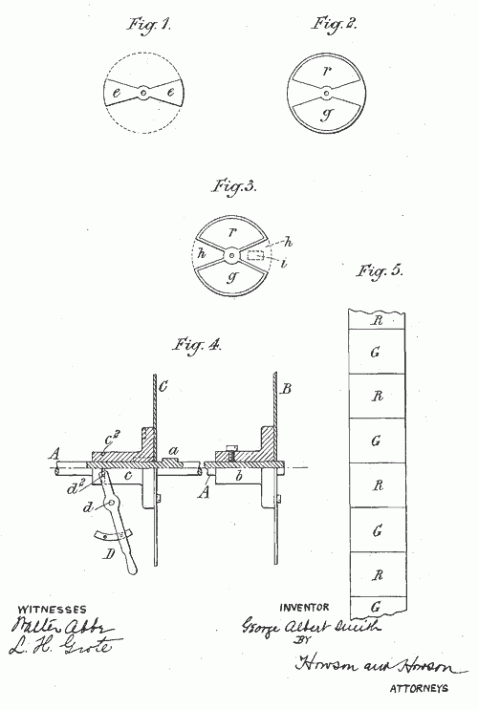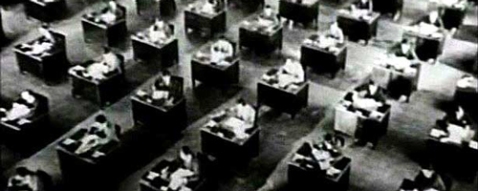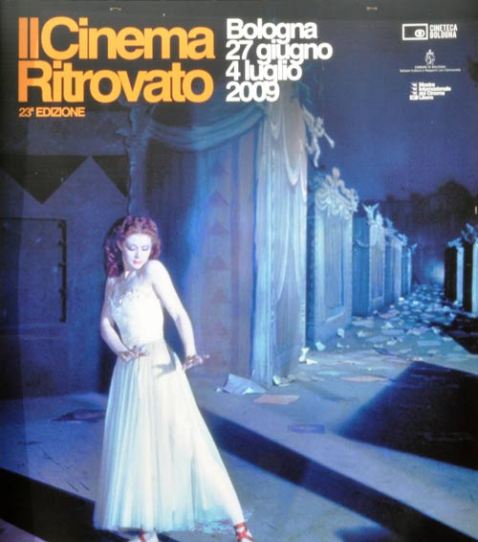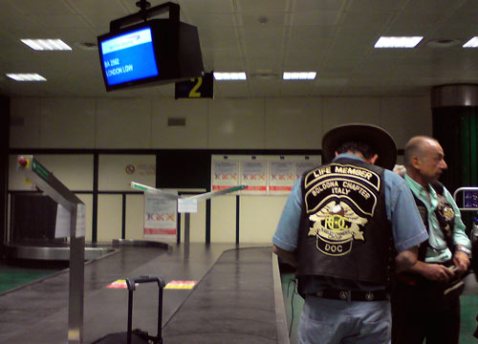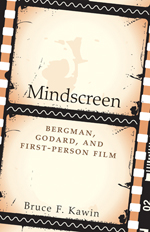Oxford Road

Over the past 6 months I’ve worked on a project called Oxford Road, which includes using film as research, mapping and working with archives. You can read more about the journey and my directing experience at the blog Oxford Road here: oxfordroad.wordpress.com
As part of the project, working with my usual collaborator, writer Erinma Ochu, we have made a 10 minute film. A draft cut was screened in june 2011 at Ptich!, an event at The Stables in Milton Keynes for the Cultural Leadership Programme.
I recently attended a weeks training in Craft Editing and a week on Single Camera Directing at BBC Academy, both which really helped delivering the first draft of the film.
Lab Week – Film Repair
Yesterday we had a workshop in the film repair lab. Various states of film were show to us and repaired with amazing fluidity. Here they try to use as little tape as possible and recreate the flexibility of the film as much as possible. There were two mechanical cement splicers and some hand splicers but we were encouraged to do all the repairs manually (good if there is shrinkage in the film).
There are 3 main repairs;
Splicing for those where a frame needs to be dropped or a film is broken in two down the width of the film reel (ie. between frames).
Perf repair which exist as the holes on the film where the sprockets catch the film – ranging from a single perf cut to a very long section of perforation missing on a reel.
Tear repair which can appear anywhere in the film but often starts at the perf and enters the picture frame.
The Australian National Film and Sound Archive has a good online resource about film repair and archive work: http://www.nfsa.gov.au/preservation/film_handbook/film_repair.html
Day 2 – 6 at Il Cinema Ritrovato

Via Azzo Gardino, 65 Bologna
It’s been hard to blog from Bologna, i’m either busy with seminars and films, and I cannot find a strong wifi connection. Memorable films include A Stravinsky Portrait (Richard Leacock, 1965), which is rather funny, free-style documentary of Stravinsky as a comic old man. Make Way for Tomorrow (Leo McCarey, 1937), a film about two elderly people dependant on their children and watching the world pass them by. Its amazing how funny and relevent this 1937 film is today – thats family politics – its travels with the generations. Another colour programme on 29th June in cinema Arlecchino, one of my favorite films in the programme was Tartans of Scottish Clans (G. A. Smith, 1906); a tartan on screen is dropped to reveal another tartan, shot in Kinemacolor (Smith invented this process) which projected a black and white film behind red and green filters – watch it for yourself here: http://www.youtube.com/watch?v=IbWtviN4BG0 and read Smith’s patent here: http://www.google.com/patents?id=pxNfAAAAEBAJ&zoom=4&pg=PA1
Other films I enjoyed in the colour programme were Deauville-Trouville, La Plage et le Front de Mer (1912) (includes some good shots of Honfleur), The Open Road (Friese-Greene, 1924-6) and L’ame des Moulins (Alfred Machin, 1912).
The Crowd (King Vidor, 1927) was screened in Piazza Maggiore with a live score. It looked fantastic (you can also lipread the characters) and the music was certainly interesting (I didn’t like the singing) – it was jazzy-prog rock (there was a hint of Argento’s Goblin soundtracks).
Festival – day 1
On day 1, I viewed:
Jean Epstein’s L’Or Des Mers (France, 1932)
The Shanghi Gesture (Josef von Sternberg, USA 1941) – dodgy representations of characters but grand set design
Alla ricerca del colore dei film programme 1
The Red Shoes (Powell and Pressburger, GB 1948) – looked amazing after restoration
Il Cinema Ritrovato – Bologna 2009
I am in Bologna for the next three weeks attending the festival, Il Cinema Ritrovato and FIAF Film Restoration Summer School. Somehow I have managed to not pack any pens at all, which is odd as I usually carry a large assortment. I feel a little lost without something to write with.
So, having borrowed a bike from my hotel (Astoria, I’m staying in a lovely clean apartment) I have a mission to find some pens then off to get my festival pass. Whilst writing this post though, a rain storm has started… I don’t have an umbrella… i’m trapped!
Mindscreen: Bergman, Godard, and First-Person Film by Bruce F Kawin
I would like to read Mindscreen: Bergman, Godard, and First-Person Film by Bruce F Kawin.
About the book:
“In the opening chapter of this groundbreaking work, Bruce Kawin asks: can a film—which is already the dream of its maker and its audience, and which can present itself as the dream of one of its characters—appear, finally, to dream itself? Contrary to the classic assumption that all film narration is third person, the author contends that a movie can be narrated in first person through a consciousness that originates either on screen or off.
Through a discussion of Keaton, Welles, Resnais, Bergman, Godard, and even Chuck Jones, Kawin shows how the self-reflexivity of film stimulates the aesthetic, political, and psychological processes of the audience, making possible a greater knowledge and acceptance of ourselves.”
Fine Cuts
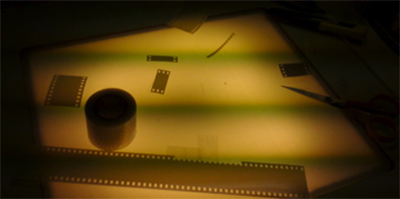 I have just read an article on Agnes Guilemot, the editor for most of Godard’s work. The last film she edited was Romance by Catherine Breillat.
I have just read an article on Agnes Guilemot, the editor for most of Godard’s work. The last film she edited was Romance by Catherine Breillat.
Guilemot compared film editing to music conducting; for editing, she felt her work came through rhythm to ‘listen, feel, receive and then transmit’. She didn’t want to invent stories and compose, so, for Guilemot, her role was not that of a director.
I am interested in this as my main role has been to edit, I think, listen and feel from that perspective. However, I now want to develop my directing, and part of being a good director, I think, means to let go of this and let the editor take control of that process.
The editor can ‘listen afresh’, and ‘produce what it (the film material) can do. The object inside must be made to come out’. After scriptwriting, then production, I don’t think a director can (often) deliver that new-born as the main editor; without tainted sight, idea or that want to keep on discovering – very much like a painter that goes too far on the canvas. A director as a leader needs to know when to let go, and to find those who they can trust to understand their vision.

